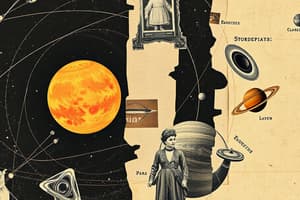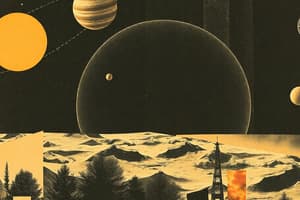Podcast
Questions and Answers
What event directly led to the formation of the dust clouds that eventually formed the solar system?
What event directly led to the formation of the dust clouds that eventually formed the solar system?
- The gravitational pull of a newly formed rocky planet.
- The compression of hydrogen gas at the center of a nebula.
- The explosion of an ancient star, scattering materials into space. (correct)
- The emission of a massive solar wind from a new star.
The solar wind played a crucial role in clearing the inner solar system of remaining dust and gas, contributing to the organized structure observed today.
The solar wind played a crucial role in clearing the inner solar system of remaining dust and gas, contributing to the organized structure observed today.
True (A)
What process occurring at the heart of a giant nebula marked the birth of the sun?
What process occurring at the heart of a giant nebula marked the birth of the sun?
nuclear fusion
The solar system is located approximately 26,000 light years from the ______ of the Milky Way galaxy.
The solar system is located approximately 26,000 light years from the ______ of the Milky Way galaxy.
Match each planet type with its location in relation to the sun:
Match each planet type with its location in relation to the sun:
Flashcards
Solar System's Location
Solar System's Location
Approximately 26,000 light years from the Milky Way's center.
Planet Formation
Planet Formation
Form from dust and gas clouds containing elements like nitrogen, oxygen, iron, and silica after an ancient star exploded.
Sun's Birth
Sun's Birth
At the center of the nebula, hydrogen atoms fused, birthing the sun and emitting solar winds that cleared the solar system.
Solar Wind
Solar Wind
Signup and view all the flashcards
Gas Giants
Gas Giants
Signup and view all the flashcards
Study Notes
- The solar system is approximately 26,000 light years from the Milky Way's center.
- This position is about 2/3 of the way out from the center of the galaxy.
- The planets orbit a typical yellow star and formed over six billion years ago.
- An ancient star's explosion long ago scattered swirling clouds of materials into space.
- Nebulae are similar dust fields observed in space currently.
- The dust clouds contained elements like nitrogen, oxygen, iron, and silica.
- Gravity initiated planet formation by pulling the dust together.
- Vast dust spirals formed, with the rocky planet Earth taking shape at the center.
- Earth grew into a giant ball, accumulating billions of tons of celestial debris over 100 million years.
- 93 million miles away, hydrogen gas compressed and atoms began to fuse, birthing the sun.
- The sun emitted a massive solar wind, dispersing the remaining dust and gas to the solar system's edge.
- The solar wind contributes to the orderly arrangement of the solar system today.
- The outer solar system contains the gas giants: Jupiter, Saturn, Uranus, and Neptune.
- The inner solar system is home to the denser, rocky planets: Mercury, Venus, Mars, and Earth.
- The sun has a diameter of 865,000 miles.
- The sun is expected to burn consistently for 8 billion years.
- This lifespan is sufficient for life to develop.
Studying That Suits You
Use AI to generate personalized quizzes and flashcards to suit your learning preferences.




